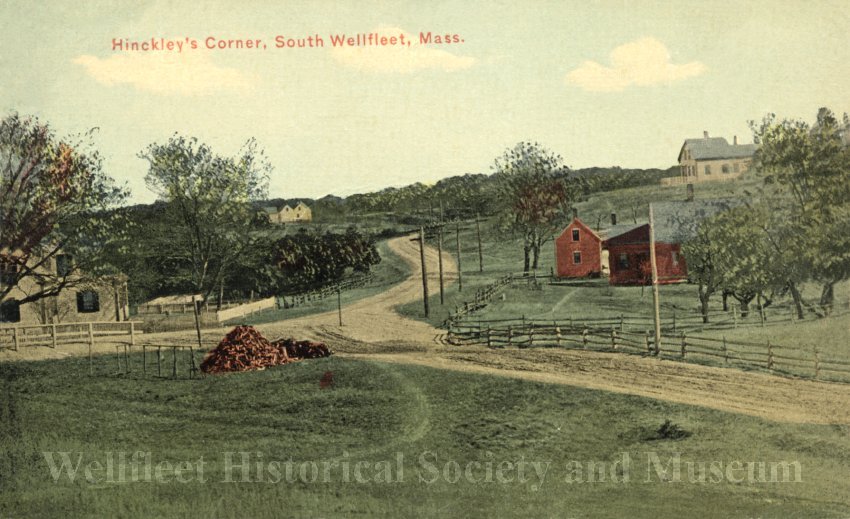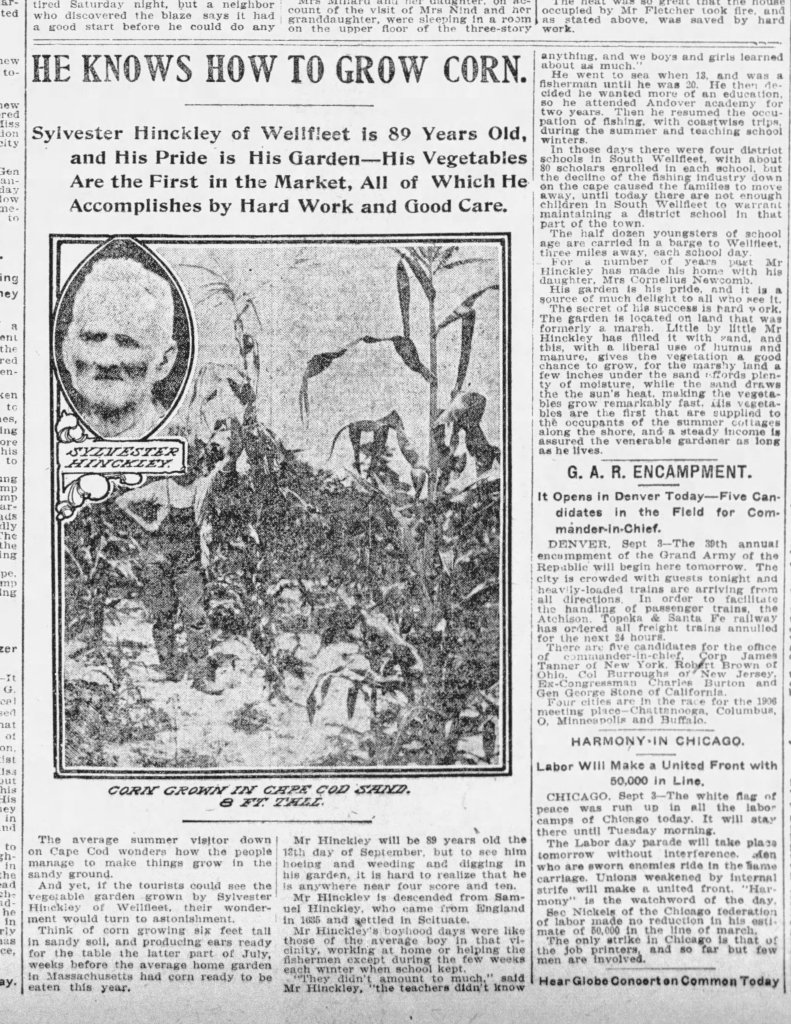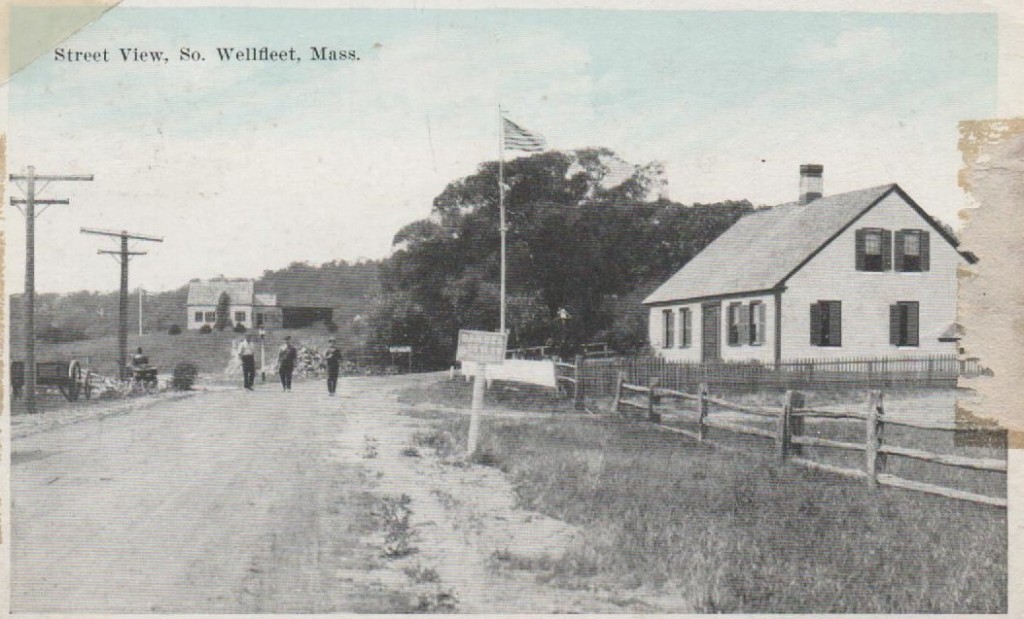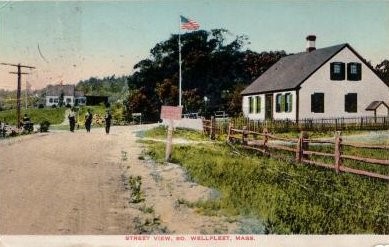
In December 1931, the Hyannis Patriot newspaper covered the birthday of South Wellfleet resident Mrs. Mary Newcomb who was celebrating her 85th birthday. Although she had a bit of rheumatism, the reporter found her cheerful and engaged with an interest in current events as she listened to her radio.
Mrs. Newcomb was born Mary Hinckley, and her home was the house that still stands today at South Wellfleet’s Hinckley’s Corner. In 1931, it was located on the “State Road” (Route 6). Today that road is named “Way 112” a byway to Route 6. The house—and the corner—are where Way 112, Paine Hollow Road, and Drummer Cove Road converge.
The Hinckley Family
Mrs. Newcomb had her family genealogy handy on the day the reporter interviewed her, perhaps reflecting the veneration of Colonial times in her day. She began with her first-generation ancestor in Plymouth Colony, Thomas Hinckley, who came to Plymouth in 1635 with his parents and went on to become a leading citizen, serving as the Colony’s last governor from 1680 to 1692. The Hinckley family followed their pastor, Reverend John Lothrop, who had come to the Colony from England to practice his religious freedom. He settled his congregation first in Scituate and later in the newly established Barnstable village.
Thomas Jr. made his family life there, marrying twice and leaving seventeen children. He played an important role as Governor in keeping Plymouth Colony as part of Massachusetts Bay Colony instead of part of New York. The 1691 Charter signed with King William and Queen Mary, created three counties, Plymouth, Bristol, and Barnstable. from the old Plymouth Colony.
Thomas Hinckley’s rather brutal time is reflected in an old record of his role as a judge in a case involving a burglary committed by a Native American who was then enslaved as a punishment. Hinckley is buried in the old Lothrop Hill Burying Ground in Barnstable.
The Hinckley family spread out over Cape Cod, and we can still see their name today as place names, business names, and the names of old houses. Fifth general Moses Hinckley, born in 1772 in Falmouth, came to Wellfleet and married Mary Chipman. In 1790, he was recorded in the first federal census in Wellfleet where he served a term as Selectman. A record of his family is in the hand-written Wellfleet birth records of that period where his daughters Mary, Nabby, Martha, Betsey, and Lavinia are recorded along with his sons Sylvester, Chipman, and Moses. Moses Hinckley is buried in Duck Creek Cemetery in Wellfleet. Sylvester, born in 1816, was Mrs. Newcomb’s father.
The Hinckley family lived upstanding lives, participating in the life of the town. Mrs. Newcomb told of her father’s teaching at the Pond Hill School when she was a child, during the winter months, and then earning a living by fishing the rest of the year. Sylvester served as the Town Auditor for many years. When he was 89 years old in 1905, The Boston Globe printed an article about Sylvester’s delicious Wellfleet-grown vegetables, coaxing his crop from the sandy Cape soil.

Mary Hinckley married Cornelius Newcomb in 1866 and, in 1871, had their only child, Herbert Newcomb.
Mary’s brothers, Moses and Sylvester, both left the Cape to pursue work as so many young men did in the latter years of the nineteenth century as the fishing from Wellfleet diminished. Both died rather young, Sylvester of suicide in May 1895, and Moses a few months later. Sylvester left a wife, Annie, and a child, Grace Hinckley.
Hinckley’s Corner
The Wellfleet Historical Society and Museum has a copy of the postcard labeled “Hinckley’s Corner” which was produced during the Golden Age of Postcards (1895-1915) when many Wellfleet locations were captured. This card is posted at the beginning of this post.
There is another postcard of Hinckley’s Corner that was only labeled “Street View South Wellfleet.

Using the Wellfleet Assessor’s Map I was able to follow the trajectory of the camera’s lens to identify the house on the right as the Hinckley family’s and the one in the distance as the Robert Paine house further up the hill. In her 1982 book Wellfleet Remembered (Volume Two), Ruth Rickmers used the same image but called the house on the right the “Cornelius Newcomb” home. By the time she produced her fourth volume of Wellfleet Remembered in 1984, Rickmers had a wonderful photograph by Gordon Spence of Hinckley’s corner with the house, the store and its Jenny gas, and several automobiles of that time. I don’t have permission to reproduce that photo here but the Rickmers books are the Wellfleet Library.

Hinckley’s Corner and the Hinckley house appear to have had their heyday in the 1920s and 1930s. Cornelius and Mary’s son, Herbert Newcomb, left the Cape and had a grocery store in Brockton, Massachusetts.
In the 1920s, as more summer residents came to Wellfleet, Herbert established a food store and a gas station next to his parents’ house. One newspaper account attributed three businesses to Herbert: Newcomb ‘s Food Shop, The Economy Wood Company, and The Tourist Chambers. The Hinckley/Newcomb house had become what we would call a “Bed and Breakfast” today. There are many mentions of The Tourist Chambers in the South Wellfleet column of the Hyannis Patriot and Barnstable Patriot naming their many guests. Annie Hinckley, Sylvester’s widow, and her daughter Grace Hinckley Austin and her four children were frequent summer visitors.
In one of his memory pieces in The Cape Codder, called “Only Yesterday,” Holman Spence remembers:
A grocer opened a store at “Hinckley’s Corner” across the street from the intersection of the King’s Highway and Paine Hollow Road. The store was called “The Palace of Sweets,” and Herbie Newcomb started it. Herbie was quite a man in the grocery business having been in it all his life in Brockton. His was an orderly place that only sold groceries and simple household goods. … He sold ice cream cones he called “five cent” or “ten cent” horns, fresh fruit, and vegetables. Jenny gasoline; kept the milk out of the sun in a cooler, and provided loafing space on the front veranda for the locals to gather upon.
At Herbie’s we kept up with old South Wellfleet friends and made a number of new ones. My oldest brother worked for Herbie driving his Model-T Ford delivery truck out across the dunes where “Wellfleet By the Sea” finally took hold and sprouted a few cottages. Herbie Newcomb was a restless sort and soon sold out to a man named Parker who, in turn, sold to people named Baumgarten. Next, he (e.g., Herbie) appeared in the center of Wellfleet in a new store called “The Trading Post” where the lawn in front of the Town Hall is now. This establishment continued until almost the second war and both my sister Marjorie and my wife worked for Herbie for a couple of years. Later it was converted to a clothing store on the second site.
(Herbert Newcomb’s Trading Post should not be confused with “Newcomb’s Soda Shop” on Main Street, owned by Cecil Newcomb.)
When Herbert Newcomb sold his South Wellfleet business to Baumgarten in 1932, it was reported that he was returning to his business in Brockton. However, once the Trading Post was established on Main Street in Wellfleet by 1936, he appears to have become a full-time Wellfleet citizen.
Hinckley’s Corner Today
Today, the term “Hinckley’s Corner” is rarely used. However, it’s commemorated in a 1998 listing on the National Register of Historic Places. The cover sheet to the application notes that “Hinckley’s Corner Historic District” is the preferred name, with “Paine Hollow North Historic District” as a secondary name. Three properties are in this District, numbers 0 (now 85), 25, and 40 Way 112. The Hinckley House and its outbuildings are number 40.
Here, the Hickley House, built in 1790, is called by the name of its original owner and builder, Jonathan Young. Mr. Young (1720-1799) inherited his land in the Paine Hollow area. The Wellfleet researchers from the 1980s indicate that he probably served on Wellfleet’s Committee of Correspondence, Inspection and Safety. He served as Town Clerk in 1781. His grave is in the South Wellfleet Cemetery.
In 1804, the Young children sold their father’s house to Moses Hinckley, identified in the deed as a carpenter.
In the National Register form, and the Massachusetts Historical Society’s “Form B” related to the Young/Hinckley House, the 1804 buyer is identified as “two brothers from up Cape,” Moses and Sylvester. However, the deed shows the only buyer to be Moses Hinckley who was the father of the two. He was probably glad to find a house in Wellfleet for his growing family. In the 1804 deed, there is a dwelling house, a barn, and land, and a “cartway” mentioned. In an 1856 newspaper account, the Hinckley House is mentioned in a description of how the new County Road should be laid out.
A 1932 description of the house in the Yarmouth Register praised its attractiveness, noting that the fireplace that was once blocked up had been re-opened. It had a parlor, a dining room, and one bedroom downstairs, with a kitchen and an ell at the back. The 1981 “Form B” noted that there is a sample of its wallpaper at the Wellfleet Historical Society and Museum. The house had an organ that entertained the neighborhood young people who would gather there to sing. Mrs. Newcomb and her husband were married there.
The Young/Hinckley/Newcomb house at Hinckley’s corner is somewhat hidden from view with trees and shrubs providing protective covering. It’s more visible during the winter season when the trees are bare. The best photos are those in the National Register of Historic Places Form 10-90, linked below. You can scroll through the form to view the photos.
National Archives NextGen Catalog
Sources
Thomas Hinckley – Wikipedia and publication: Five: “New England in Old England” 1681–1691 – Colonial Society of Massachusetts
Wellfleet Historical Society and Museum photo archive
Postcard of “Street View, South Wellfleet” in a private collection and a color version online at
Massachusetts Historical Commission Form B for 40 Way 112 (WLF )
National Register of Historic Placess catalog of forms online
The Barnstable Patriot online at the Sturgis Library
The Cape Codder, online at the Snow Library
Hinckley family genealogy at Ancestry.com
Wellfleet’s Assessor’s Database
Deeds at the Barnstable County Deed database
Rickmers, Ruth Wellfleet Remembered, Volumes 2 and 4 Wellfleet, Mass., Blue Butterfly Publications, 1982 and 1984







































